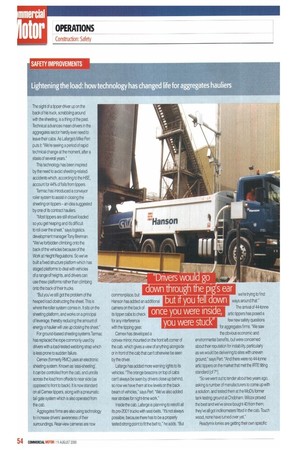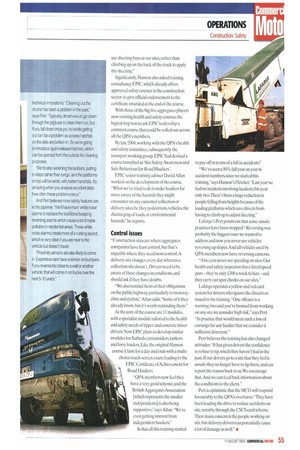g id IV . Iit11 1 146ICIPM
Page 54

Page 55

If you've noticed an error in this article please click here to report it so we can fix it.
Lightening the load: how technology has changed life for aggregates hauliers
The sight of a tipper driver up on the back of his truck, scrabbling around with the sheeting, is a thing of the past. Technical advances mean drivers in the aggregates sector hardly ever need to leave their cabs. As Lafarge's Mike Pert puts it: Were seeing a period of rapid technical change at the moment, after a stasis of several years."
This technology has been inspired by the need to avoid sheeting-related accidents which, according to the HSE, account for 44% of falls from tippers.
Tarmac has introduced a conveyor roller system to assist in dosing the sheeting on tippers an idea suggested by one of its contract hauliers.
"Most tippers are still shovel loaded so you get heaping and is difficult to roll over the sheet," says logistics development manager Tony Brennan. 'We've forbidden climbing onto the back of the vehicles because of the Work at Height Regulations. So we've built a fixed structure platform which has staged platforms to deal with vehicles of a range of heights, and divers can use these platforms rather than climbing onto the back of their trucks,
"But you've still got the problem of the heaped load obstructing the sheet. This is where the roller system comes in. It sits on the sheeting platform, and works on a principal of leverage; thereby reducing the amount of energy a haulier will use up closing the sheet.'
For ground-based sheeting systems Tarmac has replaced the rope commonly used by drivers with a load-tested webbing strap which is less prone to sudden failure.
Cemex (formerly RMC) uses an electronic sheeting system. Known as 'easi-sheeting', it can be controlled from the cab, and unrolls across the load from offside to near side (as opposed to front to back). It is now standard on all Cemex tippers, along with a pneumatic tail gate system which is also operated from the cab.
Aggregates firms are also using technology to increase drivers' awareness of their surroundings. Rear-view cameras are now commonplace, but Hanson has added an additional camera on the back of its tipper cabs to check for any Interference with the tipping gear.
Cemex has developed a
convex mirror, mounted on the front left corner of the cab, which gives a view of anything alongside Of in front of the cab that can't otherwise be seen by the driver.
Lafarge has added more warning lights to its vehicles. "The orange beacons on top of cabs can't always be seen by drivers close up behind, so now we have them at low levels on the back beam of vehicles," says Pert. "We've also added rear strobes for night-time work."
Inside the cab, Lafarge is planning to retrofit all its pre-2001 trucks with seat-belts. 'It's not always possible, because there has to be a properly tested strong point to fit the belt to," he adds. "But
we're trying to f ind ways around that."
The arrival of 44-tonne artic tippers has posed a few new safety questions for aggregates firms. We saw the obvious economic and environmental benefits, but were concerned about their reputation for instability, particularly as we would be delivering to sites with uneven ground," says Pert. "And there were no 44-tonne artic tippers on the market that met the IRTE tilting standard [of Tj.
"So we went out to tender about two years ago, asking a number of manufacturers to come up with a solution, and tested them at the MoD's former tank testing ground at Chobharn. Wilcox proved the best and we've since bought 40 from them; they've all got inclinometers fitted in the cab. Touch wood, none have turned over yet."
Readymix lorries are getting their own specific
technical innovations. "Cleaning out the drums has been a problem in the past,'' says Pert. "Typically, drivers would go down through the pig's ear to clean them out, but if you fall down once you're inside getting out can be a problem as access hatches on the side are boned on. So we're going to introduce quick-release hatches, which can be opened from the outside for cleaning purposes,
"We're also widening the ladders, putting in steps rather than rungs, and the platforms on top will be wider, with better handrails. Its amazing when you analyse accident stats how often these problems recur."
And Pert believes more safety features are in the pipeline: "We'll have more 'Mite noise' alarms to replace the traditional beeping reversing alarms which cause a lot of noise pollution in residential areas. These white noise alarms create more of a rustling sound. which is very clear if you are near to the vehicle but doesn't travel.
'Proximity sensors are also likely to come in. Expensive cars have a sensor on bumpers if you reverse too close to a wall or another vehicle; that will come in on trucks over the next 5-10 years."


































































































































































































